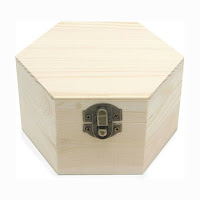Recently I saw a small, very cheap (£3), hexagonal wooden box in an art store and it just screamed at me to buy it. I had no idea as to how I would decorate it but eventually decided on marquetry to create a multi-coloured star-burst effect. The lid would be made up of several pointed pieces all meeting up in the centre. The sides would be matching veneers but running vertical from top to bottom (as most 'vertical' things do).
Obviously, work on the box began with the removal of the hinges and catch. To help with the positioning of the pieces I marked out the lid of the box and the next job was to cut 18 triangles, each with a 20 degree angle.
I laid out all my veneers so I could choose colours that are varied but that also work well with each other. It took a lot of swapping and moving sheets around until I found a combination that I was pleased with. Learning from previous mistakes, I numbered the veneers.
These veneers are extremely thin and it's very easy to break them while cutting due to the blade catching in the grain. One way I've discovered to reduce the instance of splitting is to stick masking tape on one side of the veneer. It also helps in that I can make pencil marks, etc, on the masking tape rather than on the veneer itself.
So my present process is to stick some tape onto a piece of veneer and then carefully mark out a 20 degree triangle. This was then cut out with a sharp scalpel. The triangle was then positioned on the lid of the box and I put a piece of masking tape, sticky side up, to hold the pointed ends in place.
I decided to cut opposite triangles from the same veneer and the work I put into selecting and arranging the veneers at the outset is now paying off. Obviously, at this stage, I could easily swap veneers around again but I don't see the need as I'm quite happy with the scheme as it is.
In addition to the lid I also glued the veneers to the sides of the lid and to the main box, paying close attention to making sure I get them in the right order.
Each piece was numbered to make it easier, and I also marked an arrow on each piece to show me which way the grain runs. It was a slow process because I could only work on one side at a time, and I needed each side to set before moving on to the next.
The box was sanded using varying grades of sandpaper and the surface was cleaned with a tack cloth to remove the fine particles of dust trapped in the grain. I applied a couple of coats of Shellac Sanding Sealer which fills the pores and grain of the wood. This process was repeated a couple of times, sanding between each coat with extremely fine sandpaper, until I felt it was ready for varnishing.
So here is the finished box. The Sanding Sealer was followed by 3 coats of water-based polyurethane varnish (Clear) with a light sanding after the second coat. The process was finished off with 2 coats of Finishing Wax polish, with a good buffing between each.
Every time I've done some marquetry I've finished off with a different varnish, polish or process because I've never been completely satisfied with the result. I've been aiming for a high gloss finish that doesn't yellow the wood. I think with the above process and products I've finally found a result I'm happy with.





Nice work, shared with my son as he does a bit of wood working.
ReplyDeleteThank you very much Jo.
DeleteThat's really impressive, John; nice one!
ReplyDeleteThank you John. I've just noticed that you've made a couple of posts to your blog recently - I'll pop across for a read later.
DeleteBeautiful work!
ReplyDeleteThank you very much Judy.
Delete